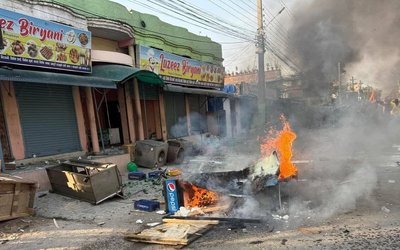
Violence against children is all too often unseen, unheard and underreported, said UNICEF today, announcing an initiative that urges ordinary citizens, lawmakers and governments to speak out more forcefully to fight violence against children.
“In every country, in every culture, there is violence against children,” said UNICEF Executive Director Anthony Lake at the global launch in New York. “Whenever and wherever children are harmed, our outrage and anger must be seen and heard. We must make the invisible visible.”
According to a press release, this is the underlying message as UNICEF launches the End Violence Against Children initiative.
At the launch in Nepal, dignitaries including activists from various child protection agencies and children, I/NGOs, diplomats, and representatives of religious and political parties gathered to make an assertive show of force to speak out against violence against children.
The ceremony in Kathmandu kicked off with children singing the Nepalese national anthem; and the launch of a powerful video narrated by Ani Choying Drolma, the renownedsinging nun from Nepal, who leads the viewer through a series of scenes depicting invisible violence.
“This boy is getting beaten by his teacher for talking in class, while the rest of his classmates watch,” she says as the camera pans through a classroom and a cane resting on the teacher’s desk. “Just because you can’t see violence against children doesn’t mean it isn’t there,” Drolma says. “Make the invisible visible. Help us make violence against children disappear. Join us. Speak out.”
The need to take urgent collective action is underlined even by the limited statistics available, which point to the scale and extent of violence. For example, globally some 150 million girls and 73 million boys under 18 years experienced sexual violence and exploitation, according to the WHO, and an estimated 1.2 million children are trafficked every year, according to a 2005 ILO report.
In Nepal, 40 per cent of all children aged 5-17 years are working. A modest estimate of 12,000 children used to be trafficked to India every year, but now the destinations and numbers have both climbed. An estimated 11,000-13,000 girls and women are working in the “night entertainment industry.” Eighty three per cent of children aged 2-14 are subject to violent discipline and 40 per cent of caregivers believe children need to be physically punished.
Violence inflicts not only physical wounds but leaves mental scars on children. It affects their physical and mental health, compromises their ability to learn and socialize and undermines their development.
“Women and children continue to be assaulted, trafficked inside and outside the country for the purpose of sexual and labour exploitation, and are subjected to harmful traditional and discriminatory practices. We can only make an impact against these violations if we all work together, from the government to civil society, and right down to the community level,"said GauriPradhan, Hon. Commissioner and Spokesperson of the National Human Rights Commission (NHRC), who was the Chief Guest at the ceremony.
Many speakers at the function, including Ani Chhoying Drolma, Sunita Danuwar, a former victim of trafficking, and Urmila Chaudhary who used to be a Kamlari (young female indentured labourer), spoke about the various forms of violence each one had faced while growing up.
Children from Haatemaalo Sanchar, a local NGO, performed a mime act to the narration of real-life stories of child abuse mailed in by young listeners of the UNICEF-supported radio programme Saathi Sanga Manka Kura (Chatting with My Best Friend). The sample reading of the letters ranged from child labour to corporal punishment and incest.
UNICEF has been a steady partner to the government and the people of Nepal since 1968 to protect and promote the rights of women and children. UNICEF’s programmes place a lot of emphasis on reaching the most disadvantaged communities, particularly children and women and persons with disabilities.
“Breaking the cycle of violence is a difficult but urgent undertaking that cannot be postponed or justified any longer. Joint efforts and action by government and non-government actors, including educators, health care authorities, legislators, law enforcement, the judiciary and the mass media is key, and we need to act fast,” said Ms. Hanaa Singer, UNICEF Representative in Nepal.
UNICEF Nepal joined the global launch of this initiative which in the coming months and year will roll out through an intense and broad campaign covering a spectrum of issues on violence faced by children in Nepal.
At the launch in New York, the initiative was unveiled with a video narrated by actor and UNICEF Goodwill Ambassador Liam Neeson, who leads the viewer through a series of scenes depicting invisible violence. The Nepalese video featuring Ani was based on this public service announcement.
Protecting children is at the heart of UNICEF’s mandate. The United Nations Convention on the Rights of the Child specifies that every child everywhere has the right to be protected from all forms of violence.
- NEPAL-THAILAND: Joint Business Council
- Apr 13, 2025
- BIMSTEC SUMMIT: Nepal’s Stand
- Apr 11, 2025
- IME GROUP: Expands Into Paper Industry
- Mar 24, 2025
- CPN UML: Instigated By India
- Mar 23, 2025
- ADB’S CHIEF ECONOMIST: Nepal Reduces Poverty
- Mar 11, 2025















